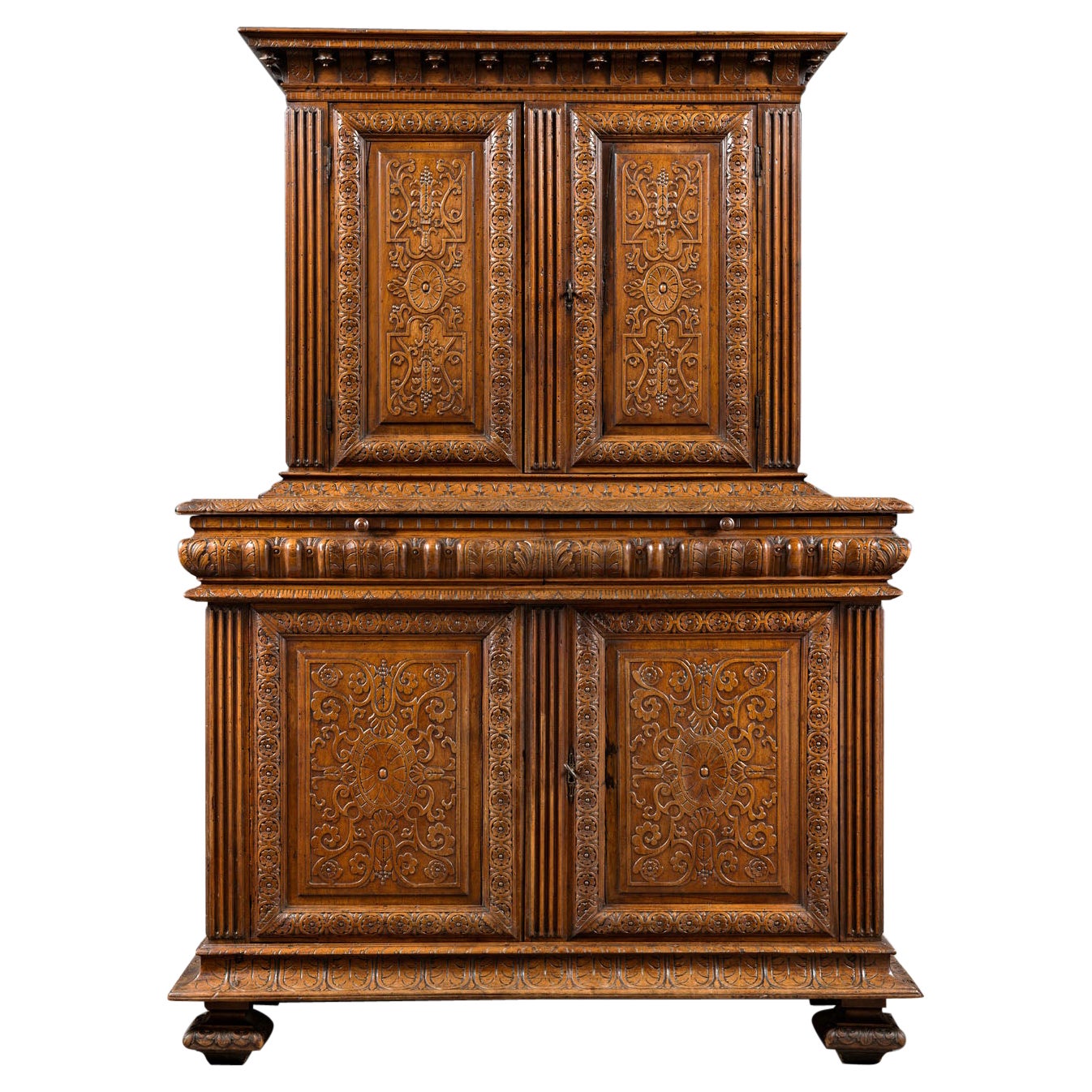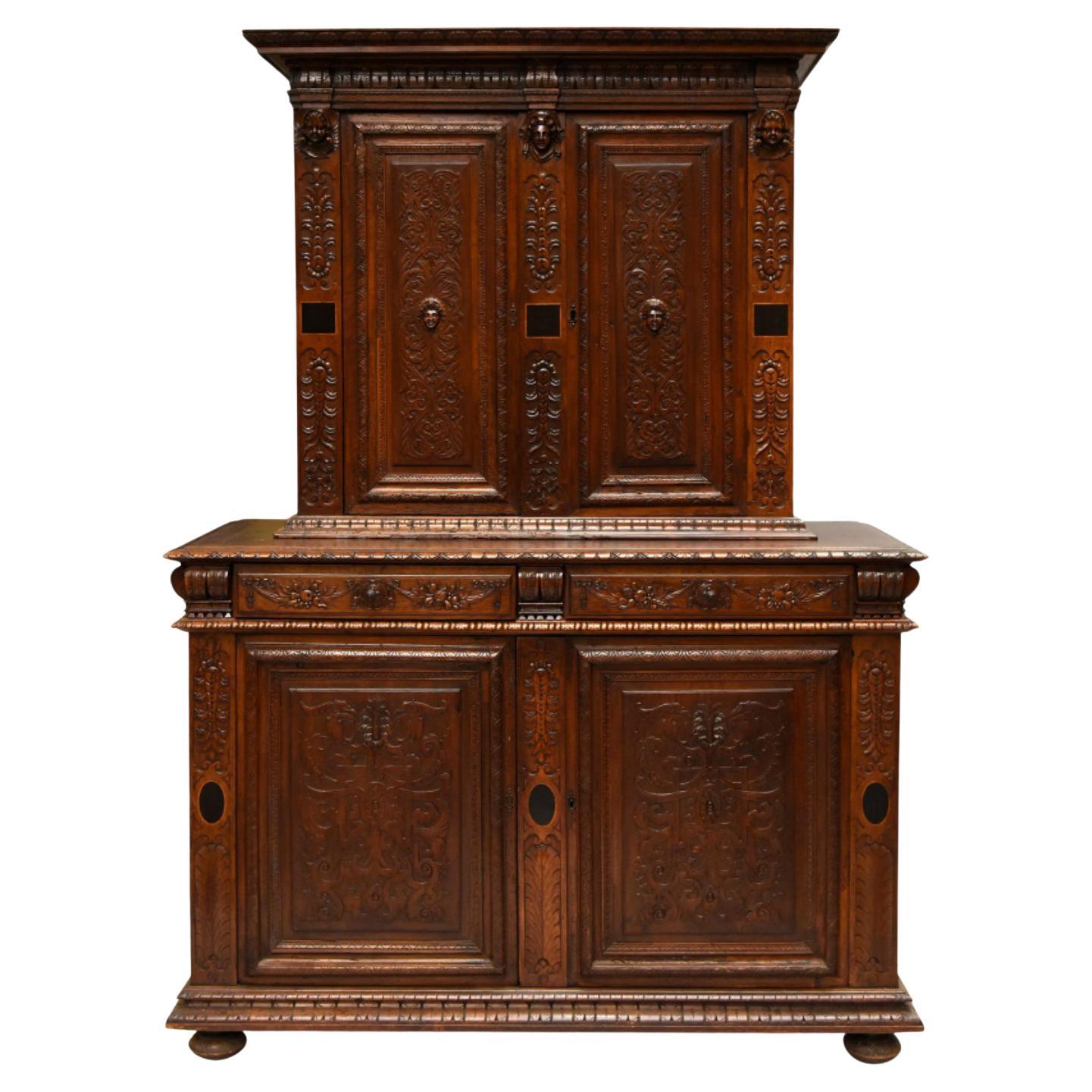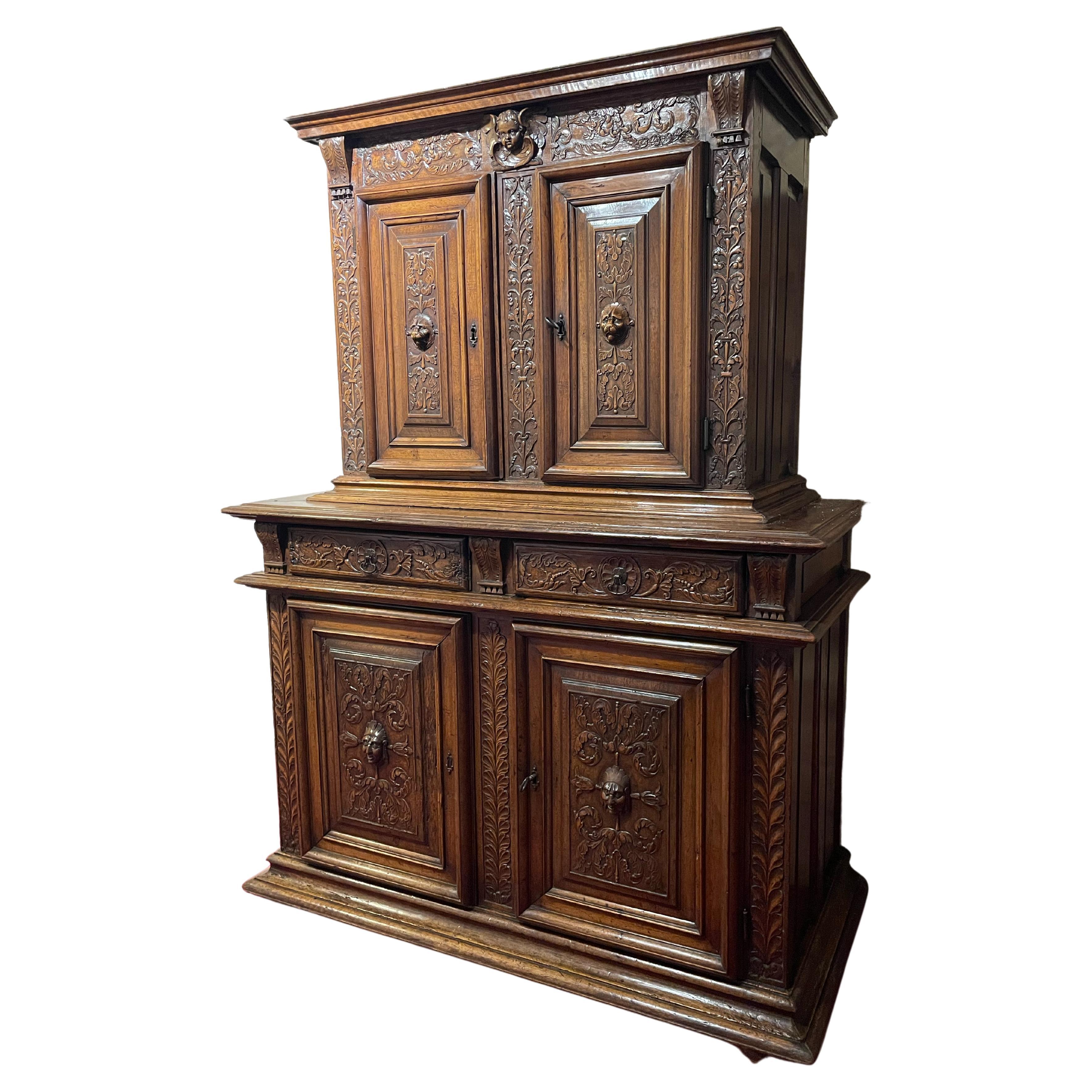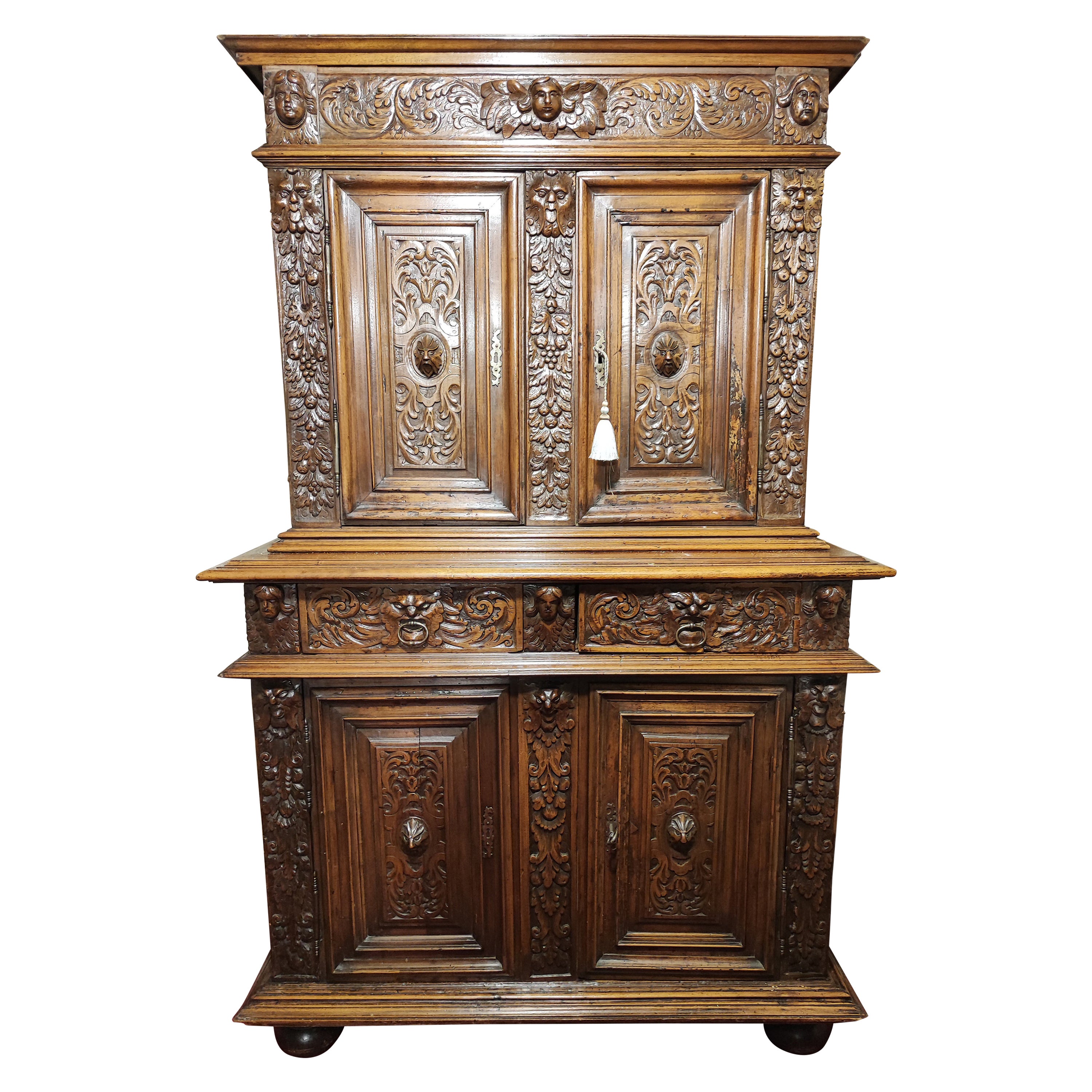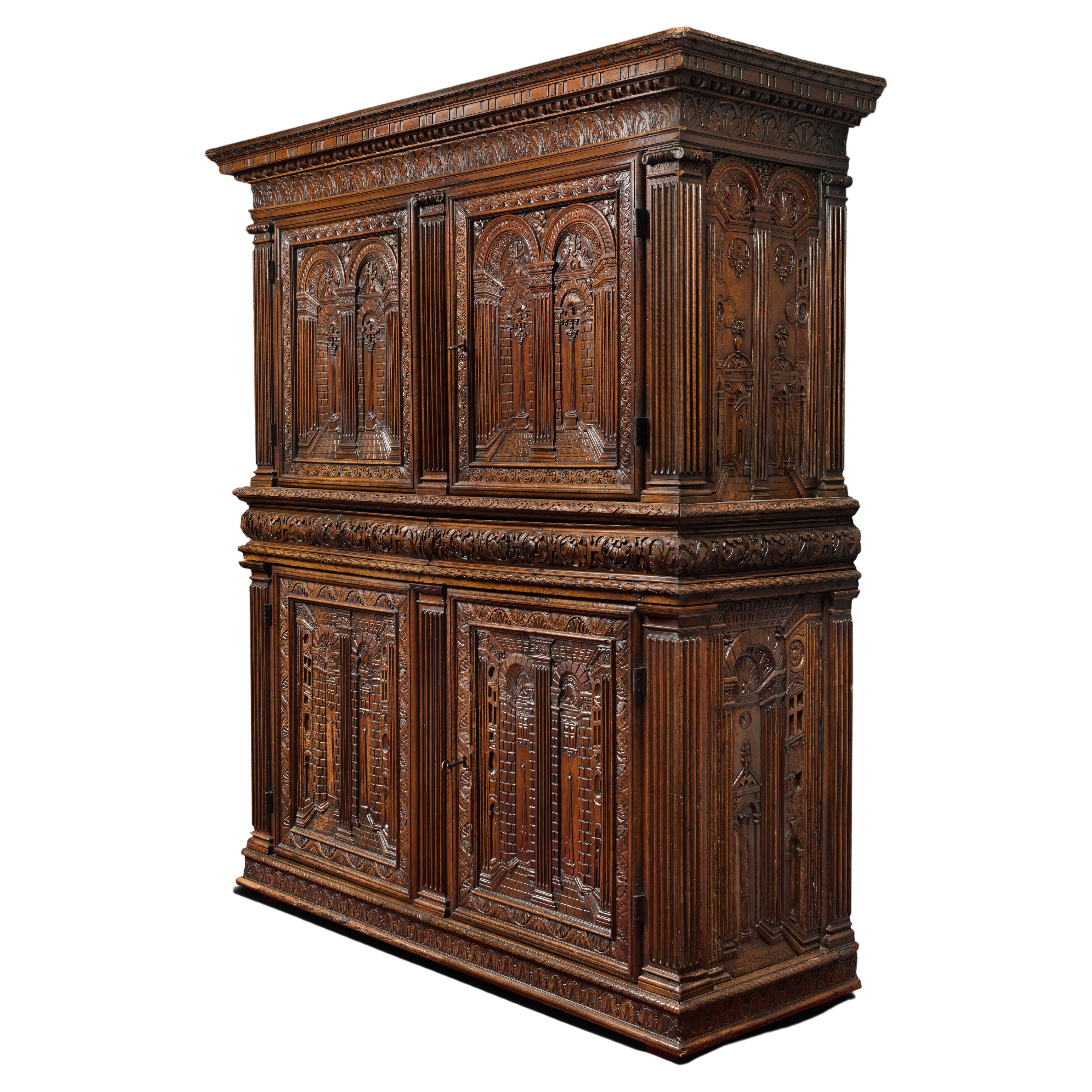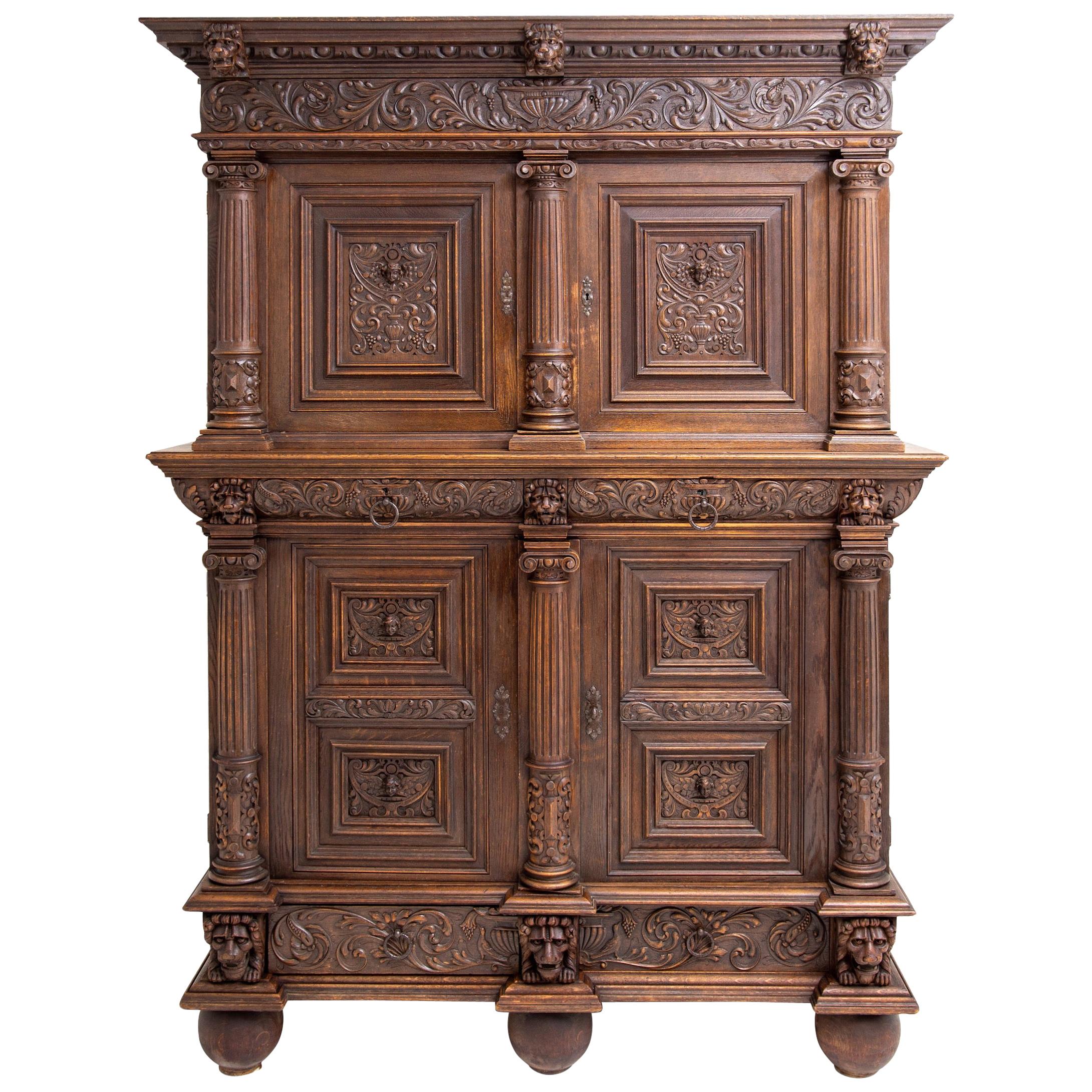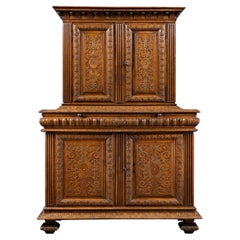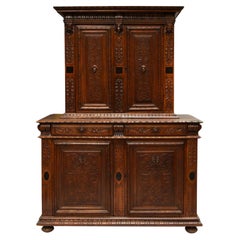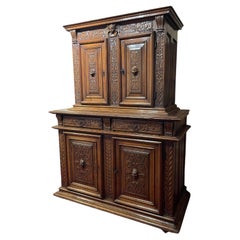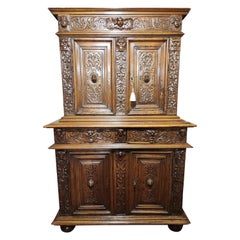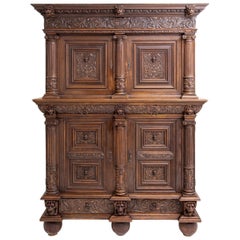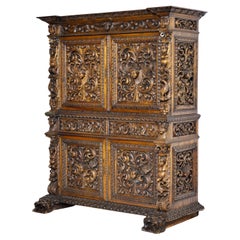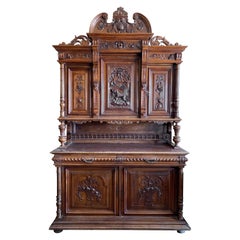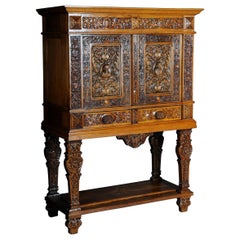Items Similar to Small Renaissance Cabinet from Lyon
Want more images or videos?
Request additional images or videos from the seller
1 of 7
Small Renaissance Cabinet from Lyon
$35,741.78
£26,553.64
€30,000
CA$49,557.58
A$53,295.03
CHF 28,496.95
MX$642,722.88
NOK 360,363.49
SEK 328,337.54
DKK 228,649.83
About the Item
Small renaissance cabinet from Lyon.
ORIGIN: FRANCE, SCHOOL OF LYON
PERIOD: 16th CENTURY
Height:151cm
Depth: 120cm
Length: 54cm
Walnut wood
Good condition
Historic
Furniture originating from Lyon during the Second French Renaissance (1540-1590) is characterised by its structure as well as its ornamentation, both granting it a specific identity. Architecture is a major inspiration for furniture ; composition and proportions obey its rules. Cabinet-makers from Lyon adopt its principles of organisation and its rigour in the balance of masses.
Furthermore the school of Lyon distinguishes itself through the use of ornaments taken from the graphic arts. Those decorative compositions comprise vermiculure, scrolls and masks treated on surface thanks to flat spot carvings. Wood-carvers and sculptors borrow those methods from Lyon young printing industry or from textiles where plumes, palm leaves and vegetal scrolls appear associated with leather scrolls.
Description
This cabinet presents a sober, strict and balanced composition. Made of two superimposed bodies standing on a protruding base supported by flat bun feet. The upper body does not show any recess but adopts the dimensions of the lower body giving the cabinet perfect balance.
A protruding belt comprising two drawers divides the two bodies. The jambs and frames are ornate with foliage and grant the cabinet a ternary rhythm. Because of this, the composition appears as much horizontal as vertical.
This very elegant piece of furniture presents a beautiful vegetal decor divided symmetrically on the four door-leaves. The panels are animated by a network of nervous and vermiculated scrolls framing a winged putto mask. From those scrolls stem animal heads with pointed beaks. The four panels are bordered with a slightly moulded mitre-cut frame with small grooves. The lateral panels are left plain.
The two drawers flank a mask carved over a drape motif while on each side are depicted winged putti heads. The drawers are enriched with interlacings and flowers. On the projected mouldings spread foliate friezes.
A cornice tops the cabinet. The entablature is carved with long leaves and flowers flanked by winged putti heads.
This rare walnut cabinet with a beautiful patina is a fine example of Lyon productions during the second half of the 16th century, allying proportion harmony with beautiful low-relief carvings covering almost the entirety of the panels’ surface. Incredible testimony of its place and time of creation this cabinet presents a unique character. The desire for rigour was undoubtedly the cabinet-makers keyword during the making of this astonishing piece.
Literature
Jacqueline BOCCADOR, Le Mobilier français du Moyen Age à la Renaissance, Éditions d’art Monelle Hayot, 1988
Jacques THIRION, Le Mobilier du Moyen Age et de la Renaissance en France, Edition Faton, 1998
Ludmila VIRASSAMYNAÏKEN (dir.), Arts et Humanisme, Lyon Renaissance, Somogy éditions d’arts, Paris, 2015
- Dimensions:Height: 59.45 in (151 cm)Width: 21.26 in (54 cm)Depth: 47.25 in (120 cm)
- Materials and Techniques:
- Period:
- Date of Manufacture:16th Century
- Condition:Repaired. Wear consistent with age and use.
- Seller Location:Saint-Ouen, FR
- Reference Number:1stDibs: LU3115330831972
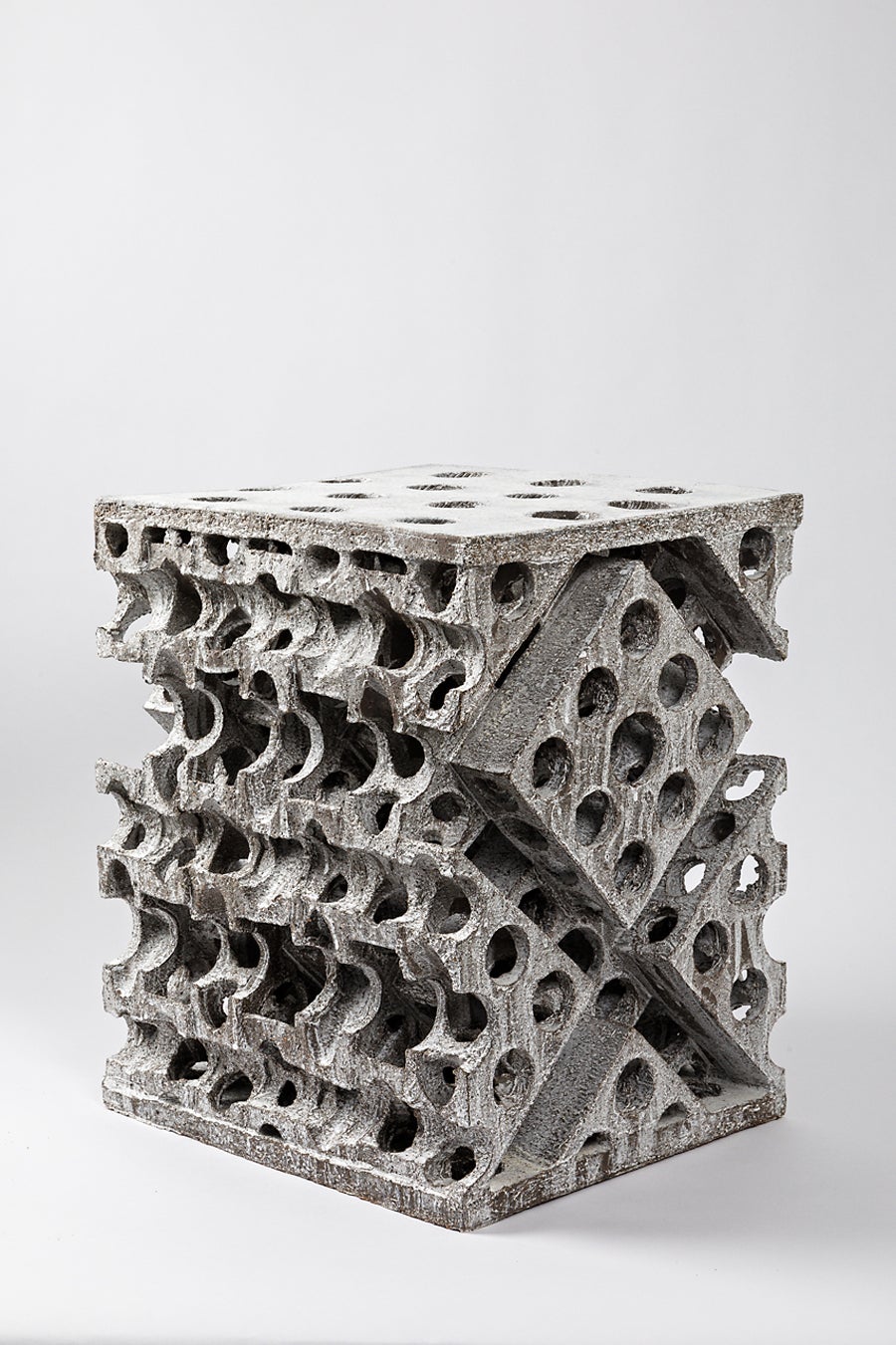
About the Seller
5.0
Vetted Professional Seller
Every seller passes strict standards for authenticity and reliability
Established in 2016
1stDibs seller since 2017
212 sales on 1stDibs
Typical response time: 2 hours
- ShippingRetrieving quote...Shipping from: Saint-Ouen, France
- Return Policy
More From This Seller
View AllExceptional Renaissance Cabinet from Lyon
Located in Saint-Ouen, FR
Exceptional Renaissance Cabinet from Lyon
Origin: Lyon, France
Period: 1540-1580, Second French Renaissance
Measures: Height: 188 cm
Length: 132 cm
...
Category
Antique 16th Century Cabinets
Materials
Walnut
Renaissance Cabinet form Lyon 'France'
Located in Saint-Ouen, FR
Condition : Partly dating from the Renaissance. The backs and the drawer’s insides have been re-done.
Historical background
The 16th century is a prosperous period for Lyon...
Category
Antique 16th Century French Renaissance Cabinets
Materials
Walnut
Small Renaissance Cabinet
Located in Saint-Ouen, FR
Small renaissance cabinet
ORIGIN : FRANCE
PERIOD : END OF THE 16th CENTURY
Measures: height: 167 cm
length: 123 cm
depth: 58 cm
This small two-part unit with harmonious proportions opens with four front leaves and two belt drawers. It rests on a molded base.
The uprights and the central frame of the lower body are adorned with long stylized palmettes. They frame the four leaves on which unfolds a vegetal decoration made of stems and leaves sculpted in symmetry around two mascarons topped with feathers...
Category
Antique 16th Century French Renaissance Cabinets
Materials
Walnut
$17,870
Small Renaissance Cabinet
Located in Saint-Ouen, FR
SMALL RENAISSANCE CABINET
ORIGIN: PROVENCE
PERIOD: END OF THE 16th CENTURY
Height: 175cm
Length: 102cm
Depth: 50cm
Blond walnut
This small cabin...
Category
Antique 16th Century Cabinets
Materials
Walnut
$17,870
Important Renaissance Cabinet from Lyon 'France' with a Decor of Perspectives
Located in Saint-Ouen, FR
As soon as 1540 France's second Renaissance is in the making, intimately linked to the rediscovery of the Antique world. The development of the printing and engraving industry allows the spread of artworks and models in many cities and countries. The Italian influence can be perceived in every artistic field. While the French king entrust the most talented Italian artists with major projects such as Il Rosso or Primaticcio in Fontainebleau, French artists also travel to Italy to form themselves to this new style. In Italy they get acquainted with the work of Leo Battista Alberti the first to theorize perspective (De Pictura, 1435-36) and architecture (De re oedificatoria, 1541). Those two publications would have a revolutionary impact on arts.
Furniture is marked by the work of the most famous Italian architects of the time as well as French architects. Indeed Philibert de l'Orme competes with Alberti and by the end of his life publishes several treaties including one devoted to a theory of architecture (1567). Unfortunately he would not live to complete the second volume. In this treaty he expresses his interest for mathematical norms applied to architecture, copied from the Antique. His journeys in Italy allowed him to accumulate the most sophisticated references. Jean Bullant, another architect of great talent also theorizes his practice. He establishes rules characterizing Greco-Roman art staying faithful to Vitruvius.
Following this new inspiration the structure of furniture evolves. From then on appear columns, capitals, cornices, friezes and architraves. The ornamentation uses this inspiration as well with egg-and-dart, palm leaf and rose adorning the most beautiful pieces.
In Lyon, crossroad where meet merchants from everywhere those new experiments are welcomed. Lyon florishing printing industry allows the spreading of models and treaties essential to the artist's work. Thus the first publication of Vitruvius' De Architectura in France would be printed in Lyon in 1532.
Artists from Lyon rediscover and familiarize themselves with the Antique knowledge very early. They adopt those new ideas and use them in their own creations. Lyon cabinet-makers re interpret Antique architecture and Italian Renaissance palaces to give their pieces a pure and harmonious architectural structure. Grooved pilasters are particularly favored. They are topped by capitals of diverse orders always respecting the sequencing with simpler ones for the lower levels and the richest ones on the higher levels. As for the ornamentation, one of the great distinctiveness of Lyon workshops remains the architectural perspective illusions, drawing inspiration from Tuscany.
True masterpiece of the Second French Renaissance this important cabinet illustrates Lyon workshops' taste for fine Italian architecture inspired by Antiquity. An architectural perspective of great quality is treated in symmetry on each panel.
This two-bodied cabinet without recess stands on four rectangular feet. The base comprises a molding, a palm leaf frieze and is bordered by a braid.
The lower body is divided by three grooved pilasters with Tuscan capitals framing two door-leaves. The two panels are encircled by a moudled frame with palm leaves. They are finely carved with a decor of fantasized architecture depicting an Italian Renaissance palace erected symmetrically on each side of a grooved pilaster. On the ground floor a door opens through a stilted arch while the stories are opened with mullioned windows, dormers and occuli. Two large pegged-boss cladded pillars support the entablature enriched by a palm leaf frieze upon which stands an arch whose coffered intrados is centred by a rose. Behind this arch a pyramid appears, standing in front of a second facade with a window topped by a broken curvilinear pediment under a cul-de-four with a shell.
The checker flooring gives depth to the low-reliefs creating vanishing points structuring the panels and guiding the eye of the observer.
A thin laurel braid highlights the belt of the cabinet where are located two drawers. Their facades are adorned by palm leaves in hoops.
The upper body is encircled with palm leaves. The same ternary division as in the lower body appears. However, the pilasters are topped by Ionic capitals with volutes and egg-and-dart. The door-leaves are framed with flowers. On the panels the artist has designed another architectural decor. On the foreground open two arches on top of grooved pilasters with rectangular capitals adorned with palm leaves. The arches are enriched with braids and the coffered intrados bears a decor of roses. The spandrels also bear a flower decor. In the background another arcature hosts a fluted grooved column topped with double basket acanthus capital, characteristic of Corinthian order. The triangular pediment is interrupted by a choux bourguignon.
A large cornice crowns the cabinet. It stands on pilasters and forms an entablature comprising a palm leaf frieze and an egg-and-dart, triglyph and palm leaf cornice.
The cabinet's sides have also been carefully considered. The lower body's panels are enriched with an arch rising above a broken pediment portico hosting a twisted column. Flowers garnish the spandrels. An architectural facade completes the decor. The upper body's panels present two arches supported by a facade opened with dormers and mullioned windows as well as cartouches (one bears the inscription 1580 dating the cabinet) suggesting the interior of an Italian Renaissance palace, confirmed by the chandeliers. The flooring leads our gaze to a second arch with a broken curvilinear pediment where stands a flower vase. This arch opens onto a perspective of another facade along a road.
Inside the cabinet, on the lower body door-leaves appear two designs. On the right door is depicted a Crucifixion. Saint Mary and Saint John flank the Christ on the cross. In the bottom part is inscribed « Dure uiator abis nihil haec spectacula curas / Pendenti cum sis unica cura Deo. / Tota suo moriente dolet natura Magistro. / Nil qui solus eras caussa dolenda doles. ». The signature [Christoff Swartz Monachiensis pinx[it] / Ioa[nnes] Sadeler sculp[it]] tells us it was made by Johan Sadeler I (1550-1600) after Christoph Schwartz (1548-1592). This engraving belongs to an ensemble depicting the Passion of Christ Johan Sadeler executed in 1589 after an altar piece painted by Christoph Schwartz for the private chapel of Renée of Loraine, wife of Duke William V of Bavaria. This altar piece made of nine copper panels has been destroyed during the 19th century. The Crucifixion panel once in the centre of the altar piece is the only one that survived and is today kept in Munich's Alte Pinakothek.
On the left door appears Saint Francis receiving the stigmata. The inscription says : « Signastidomine Servum Tuum. Franciscum. Signis Redemptionis Nostrae ».
This Renaissance cabinet with an architectural decor appearing as much in the structure faithful to Antique rules...
Category
Antique 16th Century European Renaissance Cabinets
Materials
Walnut
16th Century Renaissance Two-Bodied Cabinet
Located in Saint-Ouen, FR
Former collection Altounian
At the beginning of the reign of Henri II (1547-1559) the furniture’s ornamentation evolves. The few medieval motifs that were still used are eventually relinquished. Furniture becomes more sober showcasing moulded panels and perfect architecture. Cabinet-makers use ornaments such as curved fluted or plain columns, feather quills, roses or winged putti heads. High-relief carving becomes more scarce and compositions lighter. To that end cabinet-makers draw inspiration from Fontainebleau motifs filtering them and adapting them to French taste.
During this period cabinet-makers turn into a kind of architects. Indeed the architectural balance of furniture is the centre of their concerns. The study of Antic formulas is then a necessity. From this care given to proportions appear refined cabinets with pure lines.
This style is characteristic of the reign of Henri II and disappears soon after under the regency of Catherine de Medici (1560-1574) when an abundance of high and low-relief ornaments comes back on furnitures.
This two-bodies cabinet...
Category
Antique 16th Century French Renaissance Cabinets
Materials
Walnut
You May Also Like
Neo-Renaissance Cabinet, Late 19th Century
Located in Greding, DE
A four-door cabinet in Renaissance style standing on ball feet with lion's head mascarons and half-columns with volute capitals. The doors with panels and vine decoration are separat...
Category
Antique 19th Century German Renaissance Revival Cabinets
Materials
Wood
RENAISSANCE TWO BODY CABINET 19th Century
Located in Madrid, ES
RENAISSANCE TWO BODY CABINET 19th Century
In oak wood
Upper part with two profusely carved doors.
Lower part with two drawers and two doors.
Decorated with plant motifs, zoomorphic ...
Category
Antique 19th Century Portuguese Baroque Cabinets
Materials
Wood
Henry II Cabinet
Located in Dallas, TX
This intricately carved, beautiful wooden cabinet originates from France circa 1890. The center cabinet features a scene depicting a labrador carrying a catch of the day from hunting...
Category
Antique 19th Century French Cabinets
Materials
Wood
$15,600
19th Century Neo-Renaissance Cabinet Closet
Located in Berlin, DE
19th century Neo-Renaissance cabinet closet
Oak, solid. Richly carved, grotesque carved, two-door cabinet, centered with portrait medallions, resting on a bivouac and on pillars, ...
Category
Antique 19th Century German Renaissance Revival Cabinets
Materials
Oak
Baroque Cabinet, Mid-18th Century
Located in Greding, DE
Two-door baroque cabinet with profiled plinth and cornice as well as coffering on all sides. The pilasters are bevelled. A quatrefoil cartouche with monogram EWTS and rubbed date (17...
Category
Antique Mid-18th Century European Baroque Cabinets
Materials
Iron
Italian Renaissance Style Cabinet
Located in Sheffield, MA
Small in size but impressive in the scale of its architectural moldings and details, this Italian Renaissance-style cabinet contains two shelves b...
Category
Antique 19th Century Italian Jacobean Cabinets
More Ways To Browse
Lyon Antique
Low And Long Storage Cabinet
Cabinet Cornice
Antique Four Panel Doors
Antique Mitre
Scroll Cabinet
Frieze Cabinet
Renaissance Paris
Used Lyon Cabinets
Metal Slide
Vintage Colonial Cabinets
18th Century Glass Display Cabinet
Beveled Glass Cabinet
Bronze Mirrored Cabinet
Sevres Porcelain Plaque
Art Deco Mirror With Shelf
Liquor Cabinet
Mid Century Front Door Hardware
